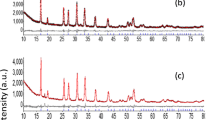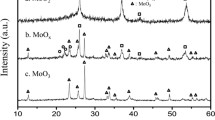Abstract
Oxide-hydrates of molybdenum (OHM) are investigated as 3-volt cathode materials for rechargeable lithium batteries. These materials with different water content showed a much better performance than that of MoO3 as cathode of the rechargeable lithium battery. We report the electrochemical characteristics of Li//OHM batteries using the oxides and oxide-hydrates of molybdenum which were synthesized from molybdic acid. The oxide has a corrugated layered structure consisting of corner-shared MoO6 octahedra. This structure provides electronic conductivity within basal layer and high lithium ion mobility between layers. The mechanism of dehydration and structural rearrangement of molybdic acid during heat treatment were studied by thermal analysis, x-ray diffraction, and Raman spectroscopy. Thermal analysis indicates a two-step dehydration and formation of orthorhombic α-MoO3 and monoclinic ß-MoO3. Discharge profiles and kinetics are dependent on the amount of “structural water” into the host lattice. The electroinsertion of Li ions occurs mainly in two steps in the potential range between 3.0 and 1.5 V (compositional range 0.0≤x(Li)≤1.5).
Similar content being viewed by others
6. References
C. Julien and G.A. Nazri, Solid State Batteries, Materials Design and Optimization, Kluwer, Boston, 1994.
M.S. Whittingham, Prog. Solid State Chem.12, 41 (1978).
J.O. Besenhard and R. Schöllhorn, J. Power Sources1, 267 (1976/77).
P. Cignini, M. Icovi, S. Panero, G. Pistoia and C. Temporoni, J. Electroanal, Chem.102, 333 (1979).
M. Icovi, S. Panero, A. D'Agate, G. Pistoia, and C. Temporoni, J. Electroanal. Chem.102, 343 (1979).
P.A. Christian, J.N. Carides, F.J. DiSalvo and J.V. Waszczak, J. Electrochem. Soc.127, 2315 (1980).
J.O. Besenhard, J. Heydecke, E. Wudy, H.P. Fritz and W. Foag, Solid State Ionics8, 61 (1983).
G. Pistoia, C. Temporoni, P. Cignini, M. Icovi and S. Panero, J. Electroanal. Chem.108, 981 (1980).
M. Pasquali, G. Pistoia and F. Rodante, Solid State Ionics6, 319 (1982).
L. Kihlborg, Arkiv Kemi21, 357 (1963).
E.M. McCarron, J. Chem Soc. Chem. Commun. 336 (1986).
S. Crouch-Baker and P.G. Dickens, Solid State Ionics32–33, 219 (1989).
I.R. Beattie and T.R. Gilson, J. Chem. Soc. (A), 2322 (1969).
J.B. Parise, E.M. McCarron and A.W. Sleight, Mat. Res. Bull.22, 803 (1987).
B. Krebs, Chem. Commun., 50 (1970).
J.R. Gunter, J. Solid State Chem. Vol.5, 354 (1972).
H.R. Oswald, J.R. Gunter and E. Dubler, J. Solid State Chem.13, 330 (1975).
R.L. Fellows, M.H. Lloyd, J.F. Knight, and H.L. Yakel, Inorg. Chem.22, 2463 (1983).
G. Guzman, B. Yebka, J. Livage and C. Julien, Solid State Ionics,86–88, 407 (1996).
F. Harb, B. Gerand, G. Nowogrocki and M. Figlarz, Solid State Ionics32–33, 84 (1989).
C. Julien and G.A. Nazri, Solid State Ionics68, 111 (1994).
C. Julien, B. Yebka and G.A. Nazri, Mater. Sci. Eng. B38, 65 (1996).
W. Weppner and R.A. Huggins, J. Electrochem. Soc.124, 1569 (1977).
G.A. Nazri and C Julien, Ionics2, 1 (1995).
G.A. Nazri and C Julien, Solid State Ionics53–56, 376 (1992).
F.W. Dampier, J. Electrochem. Soc.121, 656 (1974).
N. Margalit, J. Electrochem. Soc.121, 1460 (1974).
N. Kumagai, N. Kumagai and K. Tanno, J. Appl. Electrochem.18, 857 (1988).
M. Sugawara, Y. Kitada and K. Matsuki, J. Power Sources26, 373 (1989).
B. Yebka and C. Julien, Ionics2, 196 (1996).
M. Armand, in: Materials for Advanced Batteries (D.W. Murphy, J. Broadhead and B.C.H. Steele, Eds.), Plenum Press, New York, 1980, p. 145.
W.R. McKinnon and R.R. Hearing, in: Modern Aspects of Electrochemistry (R. White, J.O'M. Bockris and B.E. Conway, Eds.), Plenum, New York, 1983, vol. 15, p. 235.
Author information
Authors and Affiliations
Rights and permissions
About this article
Cite this article
Yebka, B., Julien, C. & Nazri, G.A. Electrochemical behavior of hydrated molybdenum oxides in rechargeable lithium batteries. Ionics 5, 236–243 (1999). https://doi.org/10.1007/BF02375846
Received:
Accepted:
Issue Date:
DOI: https://doi.org/10.1007/BF02375846




